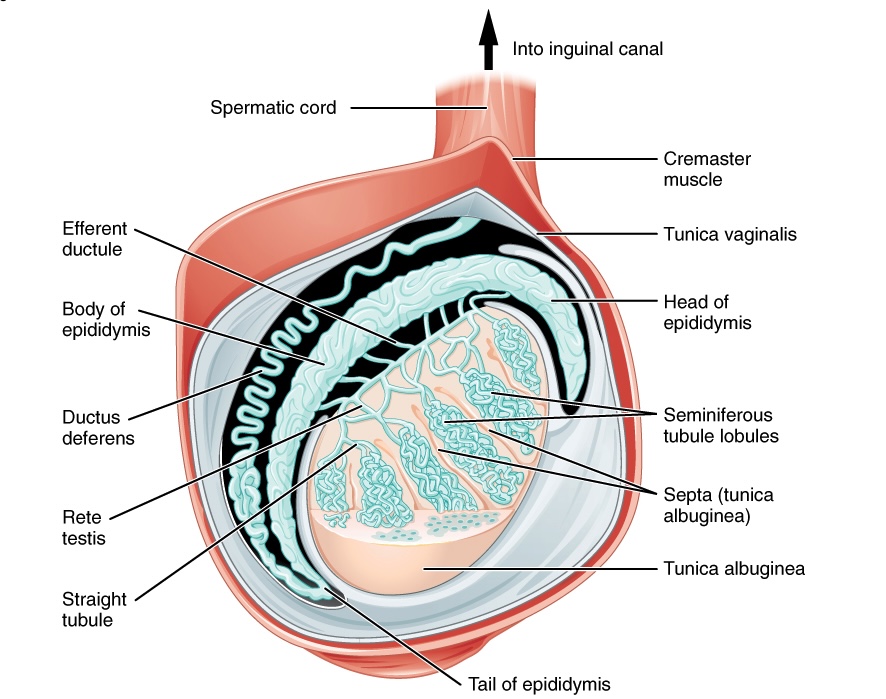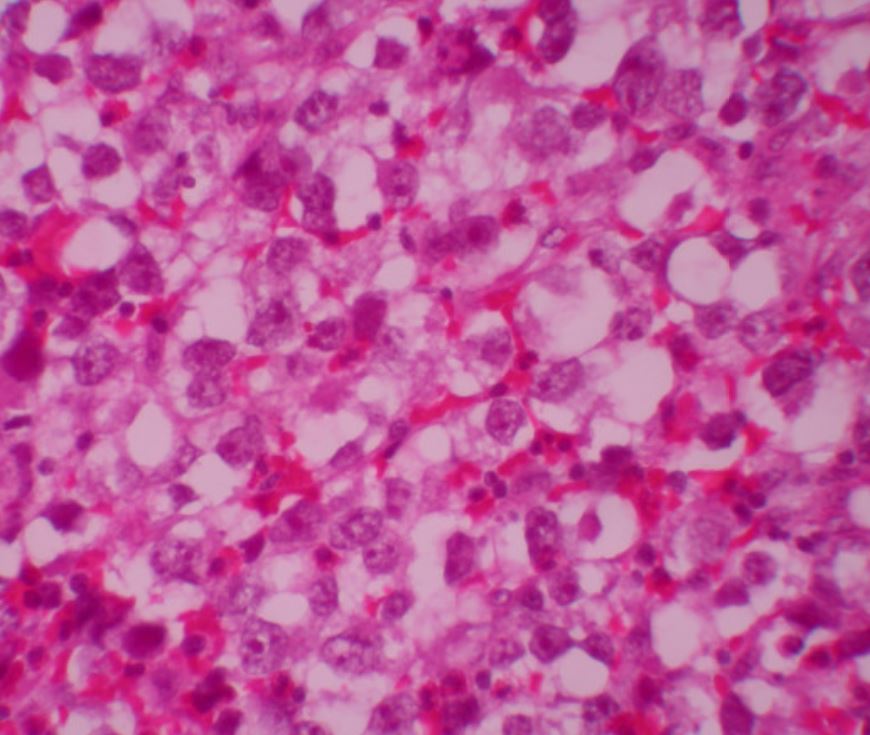Playlist
Show Playlist
Hide Playlist
Types of Germ Cell Tumors (GCT)
-
Slides Testicular Neoplasms and Prostate-Male Reproductive Pathology.pdf
-
Download Lecture Overview
00:02 Testicular tumor. 00:03 We’ll take a look at the parameters or the categories. 00:07 Tumor, morphology, marker, prognosis, remark. 00:11 Our first major germ cell tumor is a seminoma. 00:15 Take a look at the picture here. A cut section. 00:17 Do you see any blood in here? And very important – none whatsoever. 00:22 Seminoma versus a non-seminomatous germ cell tumors are non-hemorrhagic. 00:29 Sometimes referred to as being a walnut. 00:32 Okay. So if you cut open a walnut, maybe perhaps this is what it looks like on the inside. 00:36 That area that you’re seeing within the testicle, that is more whitish would be the actual tumor within the testicle. 00:43 Morphology here: Fried-egg appearance. 00:46 And by fried egg, literally means as though if you break open an egg, the yolk falls in the middle, around it will be the albumin. 00:53 The white. 00:54 That’s a fried-egg appearance. 00:56 The nucleus will be in the middle. 00:57 Fried egg is a non-specific morphology or description. 01:01 You’ve heard of oligodendroglioma, and that is a brain tumor in which there once again, the appearance – With the morphology would be fried egg. 01:10 Serum marker here, you’re going to be using what’s known as your human chorionic gonadotropin. 01:16 And you have something called placental alkaline phosphatase. 01:22 Prognosis is excellent. 01:24 Here, if you’re thinking metastasis, it will be through lymphatic. 01:28 Where is it going? Para-aortic and it is important that you pay attention to how incredibly sensitive it is to radiotherapy. 01:38 What you’re also doing is comparing this seminoma, which is the most common of all of your germ cell tumors versus the non-seminomatous, which we’ll get into next. 01:49 Embryonal: Well, the main thing here about embryonal is you take a look at the section here and you find at this section -- and you’ll find it to be hemorrhagic. 02:00 Hemorrhagic versus if you take a look at seminoma, it looks like it’s non-hemorrhagic. 02:08 Yolk sac tumor: Also call it endodermal sinus tumor (EST). 02:13 Endodermal sinus tumor But guess what? We did this for ovarian tumor as well. 02:20 And with the ovarian tumor, remember once again, ovarian tumor, this is not the most common family of tumors. 02:26 What family are we doing? Germ cell tumors. 02:30 For which gender? Males. 02:34 EST stands for endodermal sinus tumor. 02:37 Here with the yolk sac, do you remember when we had a discussion and if you haven’t quite gotten into it, that’s okay. 02:43 But the fact that glomeruli, if you have these primitive glomerular-like structures that you would find with yolk sac tumor, you call this Schiller–Duval bodies, glomerular-like. 02:54 Here, a yolk sac, the type of tumor marker you would expect to find would be alpha fetoprotein to be elevated. 03:01 Once you start getting away from seminomatous, this obviously will be a non-seminomatous testicular tumor, extremely aggressive, and here, the most common testicular tumor in a boy less than 5 years of age would be yolk sac tumor. 03:19 Something else that I wish to bring to your attention. 03:22 When we get into ovarian tumor, remember that a seminoma is then referred to as being -- or it’s equivalent in a female ovarian tumor is called a dysgerminoma. 03:33 And these are thing that we’ll discuss in ovarian tumor. 03:36 But you know me, I like to reinforce information over and over again. 03:41 I want you to think. 03:43 This is choriocarcinoma. 03:45 Choriocarcinoma would be found in two different locations and that’s how you need to approach the choriocarcinoma. 03:50 Pay attention. 03:51 Choriocarcinoma could be either gestational or could be non-gestational. 03:56 Either case, what do we mean gestational? Well, you might have heard of choriocarcinoma being an issue with the cancer of the placenta. 04:04 True. 04:05 For example, hydatidiform mole, complete mole, may then give rise to choriocarcinoma. 04:11 But that’s gestational cancer. 04:13 Where are you now? A gonad. 04:16 Which gender? The male, so testicles. 04:19 So this is testicular, non-gestational choriocarcinoma. 04:23 Therefore, morphology, you would expect to find placental tissue. 04:27 Trophoblastic. 04:28 "But Dr. Raj, we’re in the testicle?" Yes, but this is cancer. It can do whatever it wants. 04:33 Just like you would with any type of placental disorder or in general placentas involved, pregnancy, placenta involved. 04:42 And you’ve heard of the pregnancy test, beta hCG. 04:45 Aggressive. 04:47 Here, once you start getting away from your seminomatous, the non-seminomatous will be hemorrhagic, hemorrhagic and spread also would be hematogenous. 05:00 Hyperthyroidism can develop in man with non-seminomatous germ cell tumors, who have marketly elevated serum beta HCD-levels. 05:07 This is due to ligand receptor cross reactivity between the HCG and thyroid-stimulating hormones or TSH. 05:15 Do no forget these features of choriocarcinoma. 05:19 Teratoma. 05:21 Really, the only thing that I wish to bring to your attention because we’ll be dealing with teratoma quite a bit in a female. 05:26 And a teratoma in female is known as a cystic teratoma. 05:31 And with a female, we’ll be looking at the mature teratoma more so, which is benign in a female. 05:37 In a male, quite different. 05:39 A teratoma is going to be all three germ layers, so we have our endoderm, ectoderm and our mesoderm. 05:47 And the immature form will be extremely aggressive, malignant, and your next step of management here will be to resect the tumor. 05:55 Benign in children, tends to be a teratoma. 05:57 And in addition, keep in mind that teratoma can be anywhere from head to toe or head to basically the testicle. 06:05 So if it’s a child, you're most likely thinking about the sacrococcygeal. 06:09 Can you picture that? Or it could be in the midline. 06:12 And we had this discussion when we did our neoplasia. 06:15 By midline, I mean that it could be part of your pineal gland or maybe perhaps in your mediastinum. 06:20 Things that you want to pay attention to teratoma. 06:23 At this point, we have finished our discussion of germ cell tumors. 06:28 The most common family of all testicular tumors, your focus definitely should be on seminoma and some salient points about each one these other types of testicular germ cell tumors.
About the Lecture
The lecture Types of Germ Cell Tumors (GCT) by Carlo Raj, MD is from the course Male Reproductive System Diseases.
Included Quiz Questions
On physical exam, a patient has a painless testicular mass. After surgery, the pathologist reports "large cells in lobules with clear cytoplasm and a "fried egg appearance," and also the absence of hemorrhage." What is the most likely type of germ cell tumor that this represents?
- Seminoma
- Yolk sac tumor
- Embryonal carcinoma
- Teratoma
- Choriocarcinoma
Which tumor marker may be elevated in a male patient with choriocarcinoma of the testes?
- Beta-hCG
- AFP (alpha-fetoprotein)
- CEA (carcinoembryonic antigen)
- CA 125
- CA 15-3
What type of testicular cancer is associated with the tumor marker AFP?
- Yolk sac tumor
- Teratoma
- Lymphoma
- Choriocarcinoma
- Leydig cell tumor
Customer reviews
5,0 of 5 stars
| 5 Stars |
|
1 |
| 4 Stars |
|
0 |
| 3 Stars |
|
0 |
| 2 Stars |
|
0 |
| 1 Star |
|
0 |
I like the last table showing main differences of the different types of tumors.






